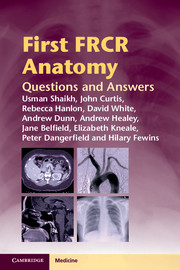Introduction
Published online by Cambridge University Press: 05 March 2012
Summary
At the time of writing, the anatomy section of the part 1 FRCR examination consists of 20 digital images presented on a computer with a 19″ monitor. Each image has five questions attached, labelled a–e. You will have 75 minutes to answer a total of one-hundred questions.
The images presented are DICOM images, which have been converted into j-pegs or tiffs in order to allow annotated symbols to be applied. These images are then converted back into DICOM and uploaded onto an OsiriX database. It is absolutely essential to familiarize yourself with this software prior to the examination. It should be noted that the OsiriX software is only available for Apple Macs and not on IBM PCs. There is however opportunity prior to the start of the examination to manipulate sample images. The answers are to be written into a booklet.
There is further information regarding the examination available on the Royal College of Radiologists website www.rcr.ac.uk which should be part of your essential revision. There are also sample questions and answers to access.
The basics are true for any examination but need to be reiterated here.
This is not an examination to be taken lightly. The anatomy learned at medical school may be far removed from radiological anatomy in the workplace. However, more and more medical schools are using radiological anatomy to educate their undergraduates. Anatomy has been ‘brought to life’ in the workplace by radiologists. A good way of learning anatomy is to sit at your PACS workstation. On one screen put up a patient's chest radiograph with a CT scan of the thorax on the adjacent screen. Scrolling through the CT study allows easier explanation of the production of interfaces seen on the chest radiograph. This applies equally as well with the abdominal radiograph and CT of the abdomen and pelvis. The anatomy tested in the examination is not beyond the scope of most of the basic radiology atlases and therefore a regular consistent approach to revision is advised.
- Type
- Chapter
- Information
- First FRCR AnatomyQuestions and Answers, pp. 1 - 2Publisher: Cambridge University PressPrint publication year: 2012



